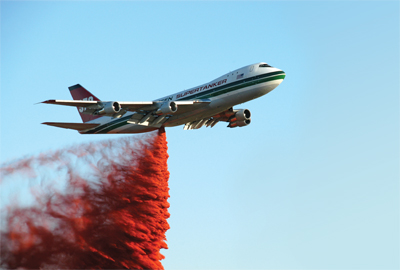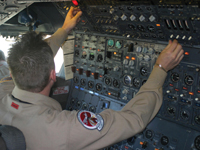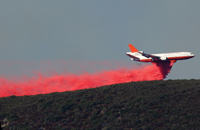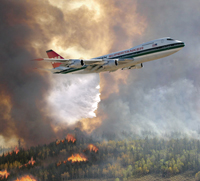
Features
Operations
VLATS-Too Hot To Handle?
As Australia takes a hard look at expanding its forest firefighting arsenal following the worst fire season in the country’s history,
April 15, 2010 By David Carr
As Australia takes a hard look at expanding its forest firefighting arsenal following the worst fire season in the country’s history, Canada appears complacent at shopping for new options despite British Columbia having struggled through two record shattering fire seasons within five years.
 |
| Evergreen’s 747 is the newest and largest of the VLATs. Converted at the cost of $50 million, the aircraft was certified in March 2009.
PHOTO: evergreen
|
On Jan. 31, a late model DC-10 nicknamed “Vicky” stopped a 250-hectare blaze in Victoria, Australia, from advancing farther by quickly laying down a retardant line, suppressing the fire along a northeast edge. Vicky is one of only two DC-10s and a single Boeing 747 series 100 in the world to have been converted into very-large air tankers (VLAT), the latest tool in the battle for aerial supremacy over wilderness fires.
Both DC-10s are owned by California-based 10 Tanker Air Carrier, and last summer were under contract by the California Department of Forestry and Fire Protection (Cal Fire) along with the single Boeing 747 owned by Oregon-based Evergreen Aviation. While still small in numbers – 10 Tanker is expected to add a third DC-10 to its fleet – VLATs are a step up from the aging Type 1 and Type 2 aircraft, the backbone of most large tanker fleets, many of which are already entering retirement.
Each DC-10 carries 44,000 litres of water or 42,000 litres of fire retardant. The aircraft can be loaded in about 10 minutes, resulting in a 20-minute turnaround, and can drop a retardant line 30 metres wide across 1.2 kilometres. Since 2006, 10 Tanker has flown 340 missions to 47 fires in California and Washington State where the aircraft proved to be extremely effective. Yet despite the number of devastating wilderness fires in 2009, including raging fires in France, Greece, Italy and Spain that consumed more than 50,000 hectares of forest in just four days, Australia is the only country outside of the United States to step up and properly test the VLAT.
Vicki has been on a three-month lease until mid-March (which as of time of writing, could be extended), arriving at Melbourne’s Avalon Airport just ahead of Victoria’s peak fire season. Australia had originally planned to test VLATs during the 2010-11 fire season but accelerated the timetable after the Black Saturday fires of 2009 claimed 400,000 hectares of bush and 173 lives. But what of Canada?
 |
| The 747 will carry 77,000 litres of liquid, which can be pumped into the airplane in approximately 18 minutes.
PHOTO: evergreen
|
On the heels of a quiet 2008, British Columbia was caught off guard last year as weeks of hot, dry weather and violent lightening storms ignited the greatest number of forest fires since 2003, the so-called Season of the Fire. In what seems like a puzzling disconnect – the sort that can only happen in Canada – B.C.’s fires were raging out of control in late July and the province was scrambling to bring in re-enforcements from as far away as Australia and New Zealand, while Evergreen’s Boeing 747 was in neighbouring Alberta casually dumping a river of water over a runway at Edmonton International Airport as part of a demonstration. While in Canada, the 747 made an unscheduled side trip to Alaska where it performed two water drops on a remote fire near Fairbanks.
The Evergreen 747 is the newest and largest of the VLATs. Converted at the cost of $50 million, the aircraft was certified in March 2009. It will carry 77,000 litres of liquid, which can be pumped into the airplane in approximately 18 minutes, and has been likened by Sam White, senior vice-president of marketing, as a “flying aerosol can” for the accuracy of its drop. Travelling at 521 knots, the 747 is twice as fast as other tankers.
Evergreen plans to add to its fleet and sees the VLAT program eventually expanding to combat oil spills, decontamination of biological/chemical poisonings and radiation knock downs. The 747 can also operate at night when fires are most vulnerable but manoeuvrability is 50 per cent riskier. So far, Cal Fire has been hesitant to attempt night missions.
VLATs will not replace existing fire suppression workhorses such as helicopters and smaller air tankers like the 7,000 litre Bombardier 415 Super Scooper, the latest in an impressive line of water bombers stretching back to the late 1960s and the Canadair CL-215. They are not, for example, first responders, when fires are smaller and accuracy is the key. Rather, VLATs are supplementary vehicles intended to lay retardant lines to prevent the spread of stubborn fires that have proven resilient to more conventional aerial retardant platforms.
A United States Forestry Service (USFS) operational evaluation concluded that, while steep and rugged terrain and reduced visibility due to smoke and ash will affect any aerial retardant delivery aircraft, these characteristics will affect VLATs to a larger degree, restricting their use for certain classes of fires, especially in small and irregularly shaped delivery zones. For example, a 10 Tanker DC-10 was pulled out of service temporarily in 2007 after nearly clipping treetops in California.
The report, prepared by NASA, recommended VLAT-class aircraft operate at 300 feet above ground level and should not be used in steep and rugged terrain unless delivery can be performed with minimal manoeuvring, adequate terrain clearance is available at both the wingtips and centreline, and a lead airplane is always available. A summary report is available online at www.fs.fed.us/fire/aviation/vlat .
 |
| Two DC-10s owned by 10 Tanker Air Carrier have been converted to very large air tankers (VLATs). PHOTO: 10 Tanker Air Carrier |
Cost is also a factor, as VLATs don’t come cheap. Evergreen bills US$3 million a month to keep its 747 on retainer, guaranteeing the aircraft would be available for a large outbreak. Australia is paying US$10 million to keep its 10 Tanker DC-10 based in Victoria for three months. In the final analysis, the price tag for cash strapped natural resources ministries might be too hot to handle.
Last year, B.C. chose to not renew its contract with Port Alberni-based Coulson Flying Tankers for its Martin Hawaii Mars, one of only two flying boats in the world (both owned by Coulson and based in California) converted to use as water bombers. As fires burned out of control across the province, the 27,000-litre Hawaii Mars sat relatively idle on contract to the USFS in southern California. Coulson’s second flying boat, the Philippine Mars was in “dry dock” undergoing extensive maintenance. Cal Fire is likely to trim its VLAT contracts, having one platform on exclusive-use, which means an aircraft can be deployed within 30 minutes and at least one more on an as-needed basis, which requires 24-hours notice and carries the risk of the aircraft being otherwise engaged.
 |
| VLATs are supplementary vehicles intended to lay retardant lines to prevent the spread of stubborn fires that have proven resilient to more conventional aerial retardant platforms.
PHOTO: evergreen
|
The price tag for leasing VLATs will haunt the potential of these aircraft in much the same way the cost of acquiring four Boeing C-17 heavy lift transports, which have recently been deployed to Haiti, dogged the Canadian Forces. Is there enough work to justify the cost? And as the frequency and destruction of wide-scale wilderness fires escalates, is it time for Canada to consider new approaches that include VLATs? Alberta has already shut the door on the VLATs, claiming the 747 is too big to land at any of the province’s 14 air-tanker bases. Because of its expansive range, the 747 is not as dependent on operating bases, needs approximately 8,000 feet of runway and can land fully loaded.
Given the flexibility of the aircraft, more pan-Canadian or even North American thinking might be called for. While based in Melbourne, Vicky was co-ordinated by Australia’s National Aerial Firefighting Centre to be deployed throughout the country. B.C. spent more than $1.3 billion on fire suppression in 2003 and 2009 alone. The worst wilderness fires on record likely cost billions more in natural resource loses, tourism and rehabilitation costs. Australia’s first report on the effectiveness of VLATs is expected in June. It should be required reading in Ottawa and provincial capitals across Canada.